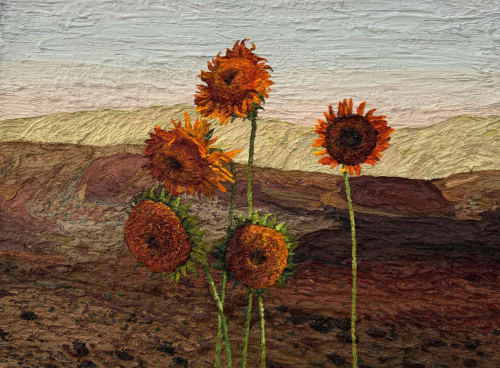In Javier Ruiz Perez’s works, it seems that suns bloom like beings, and humans grow like flowers. The exhibition Quise ser un elefante asustado - I wanted to be a scared elephant offers a field of women and men, flowers and landscapes, all bathed in the light of the evening about to dawn and a certain nostalgia.
The Spanish artist draws inspiration from an ancient tale, The Elephant and the Moon, to address two notions dear to his brush: fragility, meeting flamboyance. In a world full of noise, of speed and of the illusory impression of having to be constantly strong, the painter chooses to depict the struggle that so well defines our species: that of vulnerability versus hybris. The human being, aware of his power but confronted with his unattainable ideals, strives to do, to create, to pray, while sometimes mourning the impossibility of realizing his most incongruous desires. Life, death, the evening and a force beyond us, constantly catch up with us. That's why fear, present in the title of this exhibition, still makes us beings even remotely aware of our fragile nature, fraught with constant uncertainty, as much as it is poetic for those who know and are willing to look.
To do this, Javier Ruiz Perez uses a technique all his own: he gathers and assembles images of the world, gleaned here and there from the virtual canvas and photography. These montages, which he makes no attempt to hide, form the outlines of what he will endeavor to paint with precision, substance and rigor. These patchworks of diverse information and gestures form small, almost theatrical seynettes, which would undoubtedly be perfect for describing our humanity to a third party from elsewhere: in Ruiz Perez's canvases, we can see all our ambiguity vis-à-vis the living, between worship and abandonment, all our weirdness, all our splendor and solitude. It's a play with an unknown but strangely familiar plot, in which the living engage in a fascinating new cult, combining dance, veneration and a form of Ionescian absurdity.
Not stingy with references and with the most beautiful of human creations, the painter also brings together the most sublime glimmers of Andalusia and what the masters of the Spanish Golden Age were able to produce in their motifs. We're reminded of Velázquez's curious and singular choreographic painting, Las Meninas[1] and of Zurbarán's Saints[2], whose rich dresses and silks compete with the drama at play. Mosaics and fabrics form new garments inspired by a respected but reinvented past.
But with him, there's also, and above all, the material that speaks for itself, like a subject. It's like a cake we'd like to eat in our usual impatience. He works his paintings like a chef's recipe, generous and comforting. The oil spreads out, in colorful movements, and doesn't try to be smooth. On the contrary, it seeks to show the reality of these sometimes-disturbing dream visions; it tends to make tangible and palpable these flashes of gentle weakness, these spiritual and physical fractures, these invisible elephants, perhaps also hidden behind sunflowers.
Text by Laure Saffroy-Lepesqueur
[1] Las Meninas, Diego Velázquez, oil on canvas, 320 × 276 cm, 125.2 x 108.6 in, 1656-1657, Museo Nacional del Prado, Madrid
[2] Francisco de Zurbarán, Santa Casilda, oil on canvas, 171 x 107 cm, 67.3 x 42.1 in, 1630-1635, Thyssen-Bornemisza Museum, Santo Obispo, oil on canvas, 195 x 88 cm, 76.7 x 34.6 in, 1626-1627, Museo de Bellas Artes de Sevilla
Javier Ruiz Perez (*1989, ES) lives and works in La Carolina, Jaén, Spain.
His work is part of important private and museum collections including Museum Voorlinden, NL and The Green Family Foundation, US.


